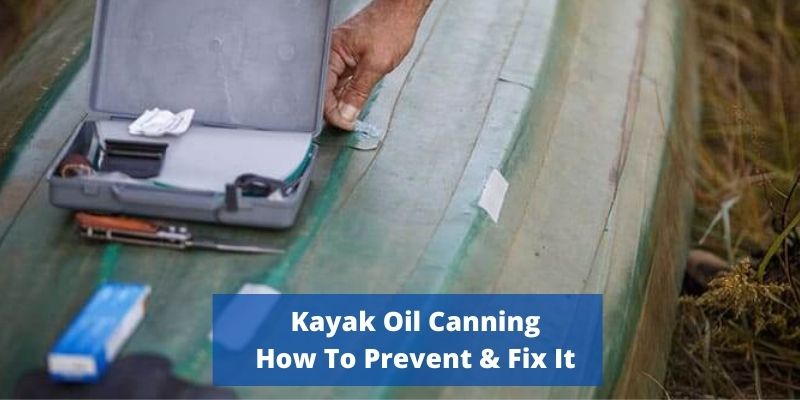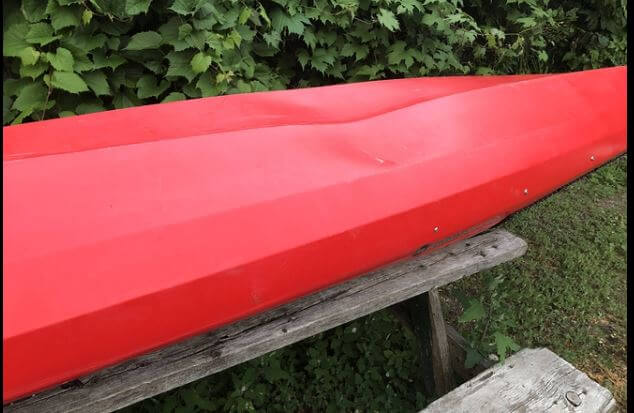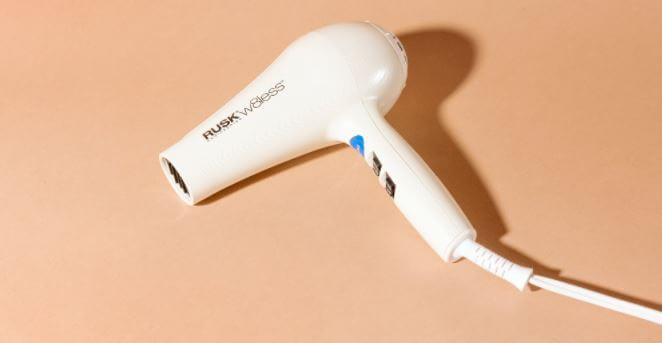If you’re looking to purchase a used kayak or fix up your own, it’s important that you know what oil canning is. In this article, we’ll discuss why and how the term came about as well as ways to identify if your kayak has been affected by oil canning so that it doesn’t lead to further issues down the line.
So before you can solve the problem of oil canned kayaks, first you need to know what exactly that is. We’ve got some advice on how to keep it from happening and what you might do to fix it.

What Is Oil Canning In Plastic Kayaks?

Oil canning is small indentations or dents that your kayak may have on its hull. These are usually caused when you tie down a yak too tightly on a roof rack or store it on the bottom of its hull for long periods of time, which creates pressure points and weakens the material’s structure over time.
Dents in your kayak or canoe can be quite annoying as they pop up and down when you’re on the water. The dents make an otherwise beautiful kayak look less appealing to onlookers.
Sometimes, dents are caused by more than just storing or carrying in an improper manner. For example, if you’re using a white-water kayak, you probably know what it feels like when you bump into rocks way too hard and notice right there in front of you that your kayak has acquired an ugly new indentation!
If you drag it along the ground, this can cause wear and tear that results in a large dent on the underside of the boat. You will usually notice it as a large dent in one section of the hull, causing an inward curve instead of outward like with other sections.
This will often happen where there have been greater amounts of stress placed upon one particular area that may be usually the roof rack.
Plastic kayaks and canoes are designed with thinner bottom hulls than sidewalls, which makes them more likely to be damaged by oil cans. In vessels that have been used a lot, it can happen. In new ones as well though.
The type of indentations that can form on a vessel’s hull is important to examine because the location and depth of these dents affect how well they will be able to perform.
The dents can affect your speed and tracking depending on where they are. It could alter the original design of your hull. You might not notice this performance issue if it doesn’t have a big impact on what kind of paddling you do.
Can We Prevent Oil Caning?
It is important to note that oil-canning may not always be preventable, but there are a few things you can do to make it less likely.
To ensure you don’t make a mess of things, always carry the canoe or kayak carefully to and from the water. Always ensure you know how to carry it and do not drag it along the ground. Lift up your entire kayak and if too heavy ask for help from someone else.
Properly storing your kayak in a way that will keep it safe and damage-free can be key to not only the longevity of its hull but also how well it performs. Kayaks should ideally be stored on their sides, either suspended or by using racks, this simple step helps avoid any unnecessary wear and tear from sitting flat against the ground for extended periods of time.
Read: How to build a kayak wooden rack
How To Fix Oil Caning Issue In Kayaks ( A Step By Step Guide) How To Get Dent Out Of A Kayak?
What you will need
- A hot sunny day
- Hair dryer
- Hot water
Step 01 – Flip Your Kayak Upside Down
To begin the repair process, turn your canoe or kayak upside down so that you can see where oil canning has occurred. The indentations are visible on the bottom of your boat’s hull and should help guide your work in repairing it.
Step 02 – Sun Light Exposure

Many kayakers do not know that sun heat can be used to fix the oil canning problem in their kayaks. What you have to do is to leave it in this flipped position. After leaving the boat in direct sunlight for up to two hours, the hull will become softened.
Step 03 – Let The Nature Work
The dents in your boat may pop out on their own after a couple of hours bringing the hull to its original shape. It will be best to leave it under the sun for perhaps 4-5 hours, but this depends on how strong the sunlight is that day.
Step 04 – Pop The Dents Out Yourself
If the sun hasn’t fixed your dented hull on its own, you can use your hands to push up from inside of the hull. The warmth and pressure should force it back into place. This allows your hull for a return to its original molded design.
Step 05 – Using A Hairdryer

I live in the snowiest state, and I love kayaking. A sunny day that is months away and oil caning is necessary! A hairdryer can come in very handy in this situation.
Warm the area where an oil canning canoe has occurred with a hairdryer by maintaining a proper distance. Be careful not to melt the plastic by holding it too close to your target spot.
Step 06 – Popping The Dents Out
The hull will get warm and that is the right time to push the dent from inside of the hull. You may find it popped on its own with the heat of the hairdryer so not have to manually do it by hand.
Step 07 – Using Hot Water
If you’re still working on getting the dents out of your yak, then try pouring hot water into the hull at the dented area.
Once the hull is heated to a high enough temperature, it should regain its original shape as the hot water would also act as a weight.
Wrapping Up
Oil canning is a common issue that occurs in both new and old kayaks. Luckily, there are several ways to fix it without too much difficulty.
Hopefully, you should now know what oil canning is. You know that it can happen with plastic kayaks and canoes of all ages and the good news! there are some easy fixes for this problem!
To reduce the likelihood of kayak oil canning, remember to treat your vessel with care when transporting and storing it.

Hi, I’m Randy R. Lios and the owner of Floating Kayaks. I’ve always been adventuresome at heart. From the time, I got my first kayak at age 18 until now when I have multiple kayaks with accessories and spend 5-6 hours researching all the new related stuff in the market. I have always been fond of fishing since my childhood and kayaking is part of my weekend routine.
